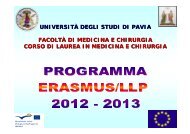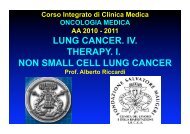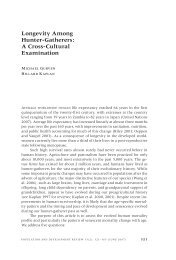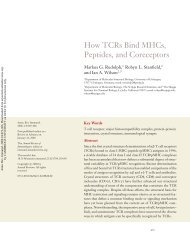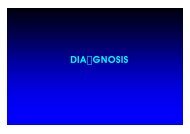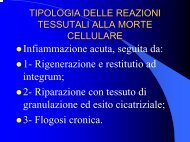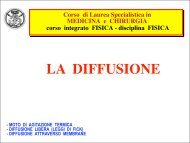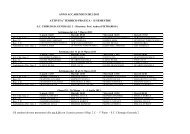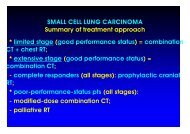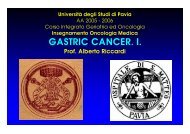Giulio Bizzozero: a pioneer of cell biology
Giulio Bizzozero: a pioneer of cell biology
Giulio Bizzozero: a pioneer of cell biology
You also want an ePaper? Increase the reach of your titles
YUMPU automatically turns print PDFs into web optimized ePapers that Google loves.
PERSPECTIVES<br />
51. Bramblett, G. T. et al. Abnormal tau phosphorylation at<br />
Ser396 in Alzheimer’s disease recapitulates<br />
development and contributes to reduced microtubule<br />
binding. Neuron 10, 1089–1099 (1993).<br />
52. Cross, D. A. et al. Selective small-molecule inhibitors <strong>of</strong><br />
glycogen synthase kinase-3 activity protect primary<br />
neurones from death. J. Neurochem. 77, 94–102<br />
(2001).<br />
53. Bienz, M. & Clevers, H. Linking colorectal cancer to Wnt<br />
signaling. Cell 103, 311–320 (2000).<br />
54. Weng, Q. P., Andrabi, K., Kozlowski, M. T., Grove, J. R.<br />
& Avruch, J. Multiple independent inputs are required for<br />
activation <strong>of</strong> the p70 S6 kinase. Mol. Cell. Biol. 15,<br />
2333–2340 (1995).<br />
55. Kim, L. & Kimmel, A. R. GSK3, a master switch<br />
regulating <strong>cell</strong>-fate specification and tumorigenesis.<br />
Curr. Opin. Genet. Dev. 10, 508–514 (2000).<br />
56. Seidensticker, M. J. & Behrens, J. Biochemical<br />
interactions in the Wnt pathway. Biochim. Biophys. Acta<br />
1495, 168–182 (2000).<br />
57. Williams, M. R. et al. The role <strong>of</strong> 3-phosphoinositide-dependent<br />
protein kinase 1 in activating AGC kinases defined in<br />
embryonic stem <strong>cell</strong>s. Curr. Biol. 10, 439–448 (2000).<br />
58. Friedman, D. L. & Larner, J. Studies on UDPG-α-glucan<br />
transglucosylase III. Interconversion <strong>of</strong> two forms <strong>of</strong><br />
muscle UDPG-α-glucan transglucosylase by a<br />
phosphorylation–dephosphorylation reaction sequence.<br />
Biochemistry 2, 669–675 (1963).<br />
59. Craig, J. W. & Larner, J. Influence <strong>of</strong> epinephrine and<br />
insulin on uridine diphosphate glucose-α-glucan<br />
transferase and phosphorylase in muscle. Nature 202,<br />
971–973 (1964).<br />
60. Cohen, P. The hormonal control <strong>of</strong> glycogen metabolism<br />
in mammalian muscle by multivalent phosphorylation.<br />
‘The Fifteenth Colworth Medal Lecture’. Biochem. Soc.<br />
Trans. 7, 459–480 (1978).<br />
61. Woodgett, J. Molecular cloning and expression <strong>of</strong><br />
glycogen synthase kinase-3/factor A. EMBO J. 9,<br />
2431–2438 (1990).<br />
62. Boyle, W. J. et al. Activation <strong>of</strong> protein kinase C<br />
decreases phosphorylation <strong>of</strong> c-Jun at sites that<br />
negatively regulate its DNA-binding activity. Cell 64,<br />
573–584 (1991).<br />
63. Sutherland, C. & Cohen, P. The alpha-is<strong>of</strong>orm <strong>of</strong><br />
glycogen synthase kinase-3 from rabbit skeletal muscle<br />
TIMELINE<br />
is inactivated by p70 S6 kinase or MAP kinase-activated<br />
protein kinase-1 in vitro. FEBS Lett. 338, 37–42 (1994).<br />
64. Cross, D. A. et al. The inhibition <strong>of</strong> glycogen synthase<br />
kinase-3 by insulin or insulin-like growth factor 1 in the rat<br />
skeletal muscle <strong>cell</strong> line L6 is blocked by wortmannin, but<br />
not by rapamycin: evidence that wortmannin blocks<br />
activation <strong>of</strong> the mitogen-activated protein kinase<br />
pathway in L6 <strong>cell</strong>s between Ras and Raf. Biochem. J.<br />
303, 21–26 (1994).<br />
65. Yost, C. et al. The axis-inducing activity, stability, and<br />
sub<strong>cell</strong>ular distribution <strong>of</strong> β-catenin is regulated in<br />
Xenopus embryos by glycogen synthase kinase 3. Genes<br />
Dev. 10, 1443–1454 (1996).<br />
66. Rubinfeld, B. et al. Binding <strong>of</strong> GSK3β to the APC–βcatenin<br />
complex and regulation <strong>of</strong> complex assembly.<br />
Science 272, 1023–1026 (1996).<br />
67. Alessi, D. R. et al. Mechanism <strong>of</strong> activation <strong>of</strong> protein<br />
kinase B by insulin and IGF-1. EMBO J. 15, 6541–6551<br />
(1996).<br />
Acknowledgements<br />
Our research is supported by the UK Medical Research<br />
Council, Diabetes UK, The Royal Society, AstraZeneca,<br />
Boehringer Ingelheim, GlaxoSmithKline, NovoNordisk and<br />
Pfizer. We apologize to the authors whose papers could not be<br />
referenced because <strong>of</strong> space restrictions.<br />
Online links<br />
DATABASES<br />
The following terms in this article are linked online to:<br />
FlyBase: http://flybase.bio.indiana.edu/<br />
wingless | zeste-white 3<br />
InterPro: http://www.ebi.ac.uk/interpro/<br />
PH | SH2<br />
Locuslink: http://www.ncbi.nlm.nih.gov/LocusLink/<br />
APC | axin | β-catenin | CDK4 | CDK6 | c-jun | CK2 | c-myc |<br />
cyclin D1 | DVL | DYRK | eIF2B | FRAT | frizzled | GBP |<br />
glycogen synthase | GSK3 | IGF1 | insulin | insulin receptor |<br />
IRS1 | IRS2 | MAPKAP-K1 | mTOR | PDK1 | 6-phosph<strong>of</strong>ructo-<br />
1-kinase | PI3K | PKA | PKB | retinoblastoma | S6K | Tau |<br />
WNTs<br />
OMIM: http://www.ncbi.nlm.nih.gov/Omim/<br />
Alzheimer’s disease | NIDDM<br />
<strong>Giulio</strong> <strong>Bizzozero</strong>: a <strong>pioneer</strong> <strong>of</strong><br />
<strong>cell</strong> <strong>biology</strong><br />
Paolo Mazzarello, Alessandro L. Calligaro and Alberto Calligaro<br />
The Italian pathologist <strong>Giulio</strong> <strong>Bizzozero</strong><br />
began his haematological investigations<br />
more than 130 years ago. Among his<br />
outstanding achievements was the<br />
discovery <strong>of</strong> the role <strong>of</strong> platelets in<br />
haemostasis and the identification <strong>of</strong> the<br />
bone marrow as the site <strong>of</strong> production <strong>of</strong><br />
blood <strong>cell</strong>s. One hundred years after his<br />
untimely death, the significance <strong>of</strong> these,<br />
and many more <strong>of</strong> his findings, is still<br />
recognized.<br />
In the 4 January 2001 issue <strong>of</strong> Nature, John L.<br />
Heilbron and William F. Bynum rightly<br />
acknowledged <strong>Giulio</strong> <strong>Bizzozero</strong> (1846–1901)<br />
— “the Italian microscopist who described<br />
red blood <strong>cell</strong>s forming in the bone marrow<br />
and platelets circulating in the bloodstream” 1<br />
— among the men <strong>of</strong> science and scientific<br />
events that they recommended for anniversary<br />
recognition. <strong>Bizzozero</strong> has also been recognized<br />
as one <strong>of</strong> the leading Italian biologists<br />
<strong>of</strong> the last two centuries by Neidhard Paweletz<br />
in his recent article on the birth <strong>of</strong> life science<br />
in Italy 2 . These are among the few references<br />
in the recent international science press that<br />
give credit to an outstanding figure <strong>of</strong> eighteenth-century<br />
<strong>biology</strong> and medicine, who<br />
made important discoveries and exerted a<br />
central role in promoting medical and biological<br />
studies in Italy.<br />
The making <strong>of</strong> a scientist<br />
<strong>Giulio</strong> <strong>Bizzozero</strong>, the son <strong>of</strong> Felice <strong>Bizzozero</strong>, a<br />
small-time industrialist, and <strong>of</strong> Carolina<br />
Veratti, was born in Varese, not far from<br />
Milan, into a middle-class family that was<br />
deeply involved in the Risorgimento — the<br />
social and political activities directed towards<br />
the liberation <strong>of</strong> Italy from Austrian domination.<br />
In 1859, while his older brother Cesare<br />
fought against Austria, his mother volunteered<br />
as a nurse at the Hospital <strong>of</strong> Varese,<br />
which was full <strong>of</strong> war-wounded patients.<br />
<strong>Bizzozero</strong> grew up in a very stimulating<br />
cultural environment, and in 1861, after his<br />
high-school classical studies, he enrolled at<br />
the University <strong>of</strong> Pavia as a medical student<br />
3,4,5 (BOX 1). During his medical-student<br />
training, <strong>Bizzozero</strong> worked for a year in the<br />
Laboratory <strong>of</strong> Physiology under the supervision<br />
<strong>of</strong> Eusebio Oehl, a steadfast advocate <strong>of</strong><br />
microscopic research. Enrico Sertoli — who<br />
identified the <strong>cell</strong>s <strong>of</strong> the seminiferous<br />
tubules <strong>of</strong> the testis — was also trained in<br />
this laboratory. Soon afterwards, <strong>Bizzozero</strong><br />
began to carry out histological and<br />
histopathological research under the direction<br />
<strong>of</strong> Paolo Mantegazza who, in 1861, had<br />
founded the Laboratory <strong>of</strong> Experimental<br />
Pathology — the first <strong>of</strong> its kind in Italy.<br />
Very gifted as a scientific illustrator,<br />
<strong>Bizzozero</strong> helped Mantegazza to prepare his<br />
publications by drawing illustrations <strong>of</strong> histological<br />
preparations.<br />
In June 1866 at the age <strong>of</strong> 20 (FIG. 1),having<br />
published several papers on different<br />
topics — including the morphology <strong>of</strong> bone<br />
marrow, the structure <strong>of</strong> skin, bones and<br />
cerebral neoplasm and the development <strong>of</strong><br />
connective tissue — <strong>Bizzozero</strong> graduated in<br />
medicine and received the Mateucci Prize,<br />
which was awarded to the student who had<br />
achieved the highest grade in all courses. On<br />
gaining his degree, <strong>Bizzozero</strong> participated as<br />
a military medical doctor in the Third<br />
Independence War against Austria. Soon<br />
afterwards, he travelled abroad to expand his<br />
scientific knowledge, visiting the laboratories<br />
<strong>of</strong> the histologist Heinrich Frey in Zürich,<br />
and the founder <strong>of</strong> <strong>cell</strong>ular pathology, Rudolf<br />
Virchow, in Berlin. In 1867, back in Pavia, he<br />
began his academic career as a deputy pr<strong>of</strong>essor<br />
<strong>of</strong> general pathology and lecturer <strong>of</strong><br />
histology, becoming the Italian prophet <strong>of</strong><br />
the new theories propounded by Virchow on<br />
the <strong>cell</strong> structure <strong>of</strong> living matter and on <strong>cell</strong>ular<br />
pathology 4,5 .<br />
In an academic environment that was<br />
dominated at the time by old-fashioned<br />
doctrines and dogmatic teaching, which<br />
presented scientific matter as truth ex cathedra<br />
and sc<strong>of</strong>fed at anyone who ‘looked into<br />
the hole’ (that is, used a microscope) 6 ,<br />
<strong>Bizzozero</strong> preached that science was ‘knowledge<br />
in progress’ that must remove its veil <strong>of</strong><br />
mystery and authoritarianism: “…the<br />
776 | OCTOBER 2001 | VOLUME 2 www.nature.com/reviews/mol<strong>cell</strong>bio
Box 1 | The University <strong>of</strong> Pavia<br />
In the nineteenth century, the University <strong>of</strong> Pavia<br />
(pictured) was the main cultural centre in<br />
Lombardy. This dated back to 1361, following an<br />
act by Emperor Charles IV, who designated it a<br />
‘Studium Generale’ and prescribed that students,<br />
rectors, doctors and functionaries should be<br />
allowed the same immunities and privileges<br />
enjoyed by the students <strong>of</strong> Paris, Bologna, Oxford,<br />
Orléans and Montpellier3 . The Studium was<br />
renowned for the great scholars that had studied<br />
and taught there, including:<br />
• Girolamo Cardano (1501–1576), a<br />
mathematician, who invented the cardan joint<br />
and provided the first printed explanation <strong>of</strong> a<br />
procedure for solving cubic equations<br />
• Lazzaro Spallanzani (1729–1799), a biologist who, among others, disproved the spontaneous<br />
generation <strong>of</strong> microscopic living beings and carried out artificial fertilization in the dog<br />
• Antonio Scarpa (1752–1832), the anatomist famous for the anatomical eponyms Scarpa triangle<br />
and Scarpa ganglion <strong>of</strong> the ear<br />
• Gaspare Aselli (1581–1625), an anatomist who discovered the chyliferous vessels in the gut and<br />
peritoneum<br />
• Alessandro Volta (1745–1827), the physicist who invented the voltaic pile<br />
• Samuel August Tissot (1728–1797), a clinician famous for his works on nervous diseases<br />
• Johann Peter Frank (1745–1821), the founder <strong>of</strong> modern public hygiene<br />
In the nineteenth and early twentieth centuries, other famous scholars linked with the University<br />
<strong>of</strong> Pavia included:<br />
• Camillo Golgi (1843–1926), one <strong>of</strong> the founders <strong>of</strong> modern neuroscience and after whom the<br />
‘Golgi complex’ or ‘Golgi apparatus’ <strong>of</strong> the <strong>cell</strong> was named<br />
• Agostino Bassi (1773–1856), the first person to succeed in the experimental transmission <strong>of</strong> a<br />
contagious disease<br />
• Alfonso Corti (1822–1876), known for his discoveries on the anatomical structure <strong>of</strong> the ear<br />
• Angelo Dubini (1813–1902), who identified Ancylostoma duodenale<br />
• Enrico Sertoli (1842–1910), the discoverer <strong>of</strong> the <strong>cell</strong>s <strong>of</strong> the seminiferous tubules <strong>of</strong> the testis<br />
that bear his name<br />
• Adelchi Negri (1876–1912), who identified what later became known as ‘Negri bodies’ in the<br />
brains <strong>of</strong> animals and humans infected with the rabies virus<br />
• Emilio Veratti (1872–1967), who described the sarcoplasmic reticulum<br />
• Battista Grassi (1854–1925), who discovered that mosquitoes were responsible for<br />
transmitting malaria between humans, and received the Darwin Medal from the Royal Society<br />
<strong>of</strong> London<br />
• Antonio Carini (1872–1950), who discovered Pneumocystis carinii, which is responsible for<br />
recurrent pneumonia in patients with AIDS<br />
(Photograph <strong>of</strong> the seventeenth-century building <strong>of</strong> the University <strong>of</strong> Pavia kindly provided by<br />
the Museum for the History <strong>of</strong> the University <strong>of</strong> Pavia.)<br />
teacher should not present science as a series<br />
<strong>of</strong> dogmas supported by the prestige <strong>of</strong> a<br />
name, … but instead expose it in its true<br />
condition, with its doubts and its<br />
questions” 7 . According to <strong>Bizzozero</strong>, laboratory<br />
training must allow the activity <strong>of</strong> many<br />
individuals to be put to the service <strong>of</strong> science,<br />
“…so that new discoveries, previously the<br />
privilege <strong>of</strong> an elite, are now not infrequently<br />
due to the perseverance and well-directed<br />
activity <strong>of</strong> a student” 7 .<br />
A good-humoured, dynamic young man,<br />
graceful and sociable — albeit with a pugnacious<br />
side to his character — <strong>Bizzozero</strong><br />
became a hero to the many students and<br />
young medical doctors, <strong>of</strong>ten older than he<br />
was, who were beginning their scientific<br />
careers under his direction. His authority was<br />
never imposed, but was always accepted as a<br />
consequence <strong>of</strong> his magnetic personality,<br />
which gave him the hallmark <strong>of</strong> a natural<br />
leader. Among his followers was Camillo<br />
PERSPECTIVES<br />
Golgi, who carried out investigations into the<br />
structure <strong>of</strong> the central nervous system that<br />
eventually led him, in 1873, to the discovery<br />
<strong>of</strong> the ‘black reaction’ (now known as ‘Golgi<br />
impregnation’ or ‘Golgi staining’). This discovery<br />
revolutionized neuroanatomical<br />
research by allowing, for the first time, a full<br />
view <strong>of</strong> single nerve <strong>cell</strong>s and their<br />
processes 6,8 . In 1877, Golgi strengthened his<br />
personal relationship with <strong>Bizzozero</strong> when he<br />
married <strong>Bizzozero</strong>’s niece, Lina Aletti.<br />
First discoveries<br />
Haematopoiesis in the bone marrow. Before<br />
his graduation, <strong>Bizzozero</strong> began to investigate<br />
the histology <strong>of</strong> bone marrow. At that time,<br />
there were two main views on the functions<br />
<strong>of</strong> this tissue, which dated back to the ancient<br />
time <strong>of</strong> Hippocrates and Aristotle. According<br />
to these views, the bone marrow either constituted<br />
an ‘excrement’ <strong>of</strong> the bone (excrementum<br />
ossium), or, on the contrary, it represented<br />
its nutritional ‘matrix’. <strong>Bizzozero</strong><br />
discovered a particular kind <strong>of</strong> nucleated red<br />
<strong>cell</strong> in this tissue, and he considered these <strong>cell</strong>s<br />
to be the precursors <strong>of</strong> the mature red <strong>cell</strong>s <strong>of</strong><br />
the circulating blood (FIG. 2).Moreover,he<br />
realized that bone marrow is the site <strong>of</strong> production<br />
<strong>of</strong> white blood <strong>cell</strong>s and also exerts a<br />
role, like the spleen, in the destruction <strong>of</strong> old<br />
<strong>cell</strong>ular elements. <strong>Bizzozero</strong>’s conclusions<br />
were confirmed by experiments <strong>of</strong> bleeding<br />
under controlled conditions, carried out on<br />
chickens and pigeons, which amplified the<br />
blood-<strong>cell</strong>-forming phenomenon in bone<br />
marrow 9–11 .<br />
The finding that bone marrow was able to<br />
produce blood was also made at the same<br />
time by the Prussian haematologist Ernst<br />
Neumann, a pr<strong>of</strong>essor at the University <strong>of</strong><br />
Königsberg, who published part <strong>of</strong> his results<br />
in 1868, a month before the Italian<br />
researcher 12 .<br />
Nodes <strong>of</strong> <strong>Bizzozero</strong> in the skin. Another field<br />
<strong>of</strong> interest for <strong>Bizzozero</strong> concerned the histological<br />
structure <strong>of</strong> the epidermis and, in particular,<br />
the points <strong>of</strong> contact between adjacent<br />
<strong>cell</strong>s <strong>of</strong> the stratum spinosum, erroneously<br />
considered at the time to be ‘inter<strong>cell</strong>ular<br />
bridges’ that established a cytoplasmic continuity.<br />
<strong>Bizzozero</strong>’s attention was captured by<br />
some peculiar shapes that he observed in<br />
these <strong>cell</strong>s, such that the processes projecting<br />
from the adjacent <strong>cell</strong>ular elements met endto-end<br />
in small, dense and dark nodules, later<br />
known as ‘nodes <strong>of</strong> <strong>Bizzozero</strong>’. <strong>Bizzozero</strong> perceptively<br />
concluded that there was no cytoplasmic<br />
continuity between these <strong>cell</strong>s, and<br />
that the dense nodules that we now call<br />
desmosomes or ‘connecting bodies’ (from the<br />
NATURE REVIEWS | MOLECULAR CELL BIOLOGY VOLUME 2 | OCTOBER 2001 | 777
PERSPECTIVES<br />
Figure 1 | <strong>Giulio</strong> <strong>Bizzozero</strong> around 1866,<br />
aged 20.<br />
Greek words desmos for ‘bond’ or ‘ligament’<br />
and soma for ‘body’), were, in fact, bipartite<br />
adhesive structures to which both <strong>cell</strong>s contributed<br />
13–15 . <strong>Bizzozero</strong>’s conclusion was not<br />
accepted at the time, owing to the influence <strong>of</strong><br />
Louis Ranvier, who propounded the opposite<br />
idea <strong>of</strong> <strong>cell</strong>-to-<strong>cell</strong> continuity. The definitive<br />
resolution <strong>of</strong> this controversy came with the<br />
advent <strong>of</strong> the electron microscope, which<br />
revealed a protoplasmic discontinuity at the<br />
level <strong>of</strong> the inter<strong>cell</strong>ular bridges, so confirming<br />
<strong>Bizzozero</strong>’s theory 16–18 .<br />
Phagocytosis in the eye. Following the discovery<br />
<strong>of</strong> the haematopoietic function <strong>of</strong> the<br />
bone marrow and the identification <strong>of</strong> the<br />
nodes <strong>of</strong> <strong>Bizzozero</strong>, <strong>Bizzozero</strong>’s third important<br />
scientific contribution came from an<br />
investigation into the mechanisms by which<br />
pus elements are produced in the inflammation<br />
process in the anterior chamber <strong>of</strong> the<br />
eye. <strong>Bizzozero</strong> gave a clear description <strong>of</strong><br />
phagocytosis in two papers that were published<br />
in 1871 and 1872 in the Italian medical<br />
magazine, Gazzetta Medica Italiana –<br />
Lombardia 19,20 , the same journal that published<br />
Camillo Golgi’s first communication<br />
on the ‘black reaction’ in 1873 (REF. 21). Using<br />
in vivo experimental conditions in rabbits<br />
and clinical observations in humans,<br />
<strong>Bizzozero</strong> described great <strong>cell</strong>ular elements<br />
(now known to be macrophages) “…that<br />
have the faculty to devour the surrounding<br />
elements” 20 . He stated that “…when an irritating<br />
process affects the wall <strong>of</strong> the anterior<br />
chamber (<strong>of</strong> the eye) … some great and lively<br />
contractile <strong>cell</strong>ular elements develop,<br />
which can swallow and introduce into their<br />
protoplasm [by means <strong>of</strong> active amoeboid<br />
movements] the elements that are immersed<br />
in the surrounding liquid” 20 ; that is, red<br />
blood <strong>cell</strong>s, pigment granules and pus particles.<br />
In the concluding remarks <strong>of</strong> his 1872<br />
paper, <strong>Bizzozero</strong> clearly explains this phenomenon<br />
as the method for eliminating pus<br />
particles or effused blood in the anterior<br />
chamber <strong>of</strong> the eye, giving an exact pathophysiological<br />
interpretation <strong>of</strong> phagocytosis.<br />
In 1873, <strong>Bizzozero</strong> even hinted at the role<br />
exerted against infection by connective reticular<br />
phagocytes <strong>of</strong> lymph nodes. In a study<br />
on the structure <strong>of</strong> lymphatic glands, he stated<br />
that reticular <strong>cell</strong>s could ingest infective<br />
particles that were carried by the lymphatic<br />
liquid 22 . He added that: “…this fact is, perhaps,<br />
the cause <strong>of</strong> the stoppage <strong>of</strong> some infections<br />
to the lymphatic glands which are connected<br />
to the part covered by the infection<br />
through the lymphatic vessels” 22 . So, the<br />
mechanism <strong>of</strong> phagocytosis as a biological<br />
phenomenon was precisely described by<br />
<strong>Bizzozero</strong> in the period between 1871 and<br />
1873, more than 10 years before Elie<br />
Metchnik<strong>of</strong>f described it 23 .However,ifwe<br />
consider a structured ‘theory’ or ‘doctrine’ <strong>of</strong><br />
phagocytosis; that is, a theory or doctrine <strong>of</strong><br />
immunity, this implies a mechanism <strong>of</strong><br />
defence from external biological aggression<br />
that could be fully proposed only after the<br />
microbiological discoveries <strong>of</strong> Louis Pasteur<br />
and Robert Koch. And this concept was<br />
structured and articulated by Metchnik<strong>of</strong>f<br />
from 1882 onwards. However, the great<br />
Russian founder <strong>of</strong> immunology never<br />
sought credit for being the first to describe<br />
the phenomenon <strong>of</strong> phagocytosis, and in his<br />
masterpiece Immunity in Infective Diseases 24<br />
gave full credit to <strong>Bizzozero</strong> for having<br />
“…first recognized … an amoeboid <strong>cell</strong><br />
which had ingested pus corpuscles”.<br />
Establishing a research laboratory<br />
In 1872, after this extremely productive period<br />
<strong>of</strong> research, <strong>Bizzozero</strong>, at the age <strong>of</strong> 26, was<br />
appointed full Pr<strong>of</strong>essor <strong>of</strong> General Pathology<br />
at the University <strong>of</strong> Turin in Piedmont, a<br />
region in the north <strong>of</strong> Italy. His arrival in this<br />
town was soon followed by a period <strong>of</strong> struggle<br />
to impose experimental methods against<br />
the vitalistic philosophy that still dominated<br />
the old Piedmontese medicine, according to<br />
which the human body was under the influence<br />
<strong>of</strong> a vital force that was independent <strong>of</strong><br />
physico–chemical law. The old academics<br />
ridiculed the microscope as the instrument<br />
“…which showed what one wanted to see<br />
and not what one must see” 25 .To overcome<br />
the difficulty in obtaining space from the university,<br />
<strong>Bizzozero</strong> set up a private laboratory<br />
in his house, which soon became an impor-<br />
tant experimental centre for morphological<br />
research. Things began to improve from<br />
1876, when <strong>Bizzozero</strong> was granted a laboratory<br />
and funding for an assistant and a laboratory<br />
technician from the university.<br />
Meanwhile, he founded the magazine<br />
Archivio per le Scienze Mediche (Archive for<br />
Medical Sciences) and, in 1879, published the<br />
first edition <strong>of</strong> his Manuale di Microscopia<br />
Clinica (Handbook <strong>of</strong> Clinical Microscopy),<br />
which was subsequently reprinted many<br />
times and translated into several languages<br />
including German and French.<br />
At the end <strong>of</strong> the 1870s, <strong>Bizzozero</strong>’s scientific<br />
activity increased enormously in the<br />
laboratory at the University <strong>of</strong> Turin, and<br />
outstanding scientific results soon followed.<br />
In 1879, he described a new instrument he<br />
had invented, named the ‘chromo-cytometer’,<br />
which allowed alterations in the content<br />
<strong>of</strong> haemoglobin in the blood to be quanti-<br />
778 | OCTOBER 2001 | VOLUME 2 www.nature.com/reviews/mol<strong>cell</strong>bio<br />
fied 26<br />
(BOX 2). With this instrument,<br />
<strong>Bizzozero</strong>, in collaboration with Golgi, was<br />
able to study the variation <strong>of</strong> haemoglobin<br />
in various pathological conditions and during<br />
blood transfusions into the peritoneal<br />
cavity, a procedure that allowed considerable<br />
quantities <strong>of</strong> blood to be transfused without<br />
Figure 2 | <strong>Bizzozero</strong>’s drawings showing<br />
developmental stages <strong>of</strong> red blood <strong>cell</strong>s.<br />
Series a shows red blood <strong>cell</strong>s in the bone<br />
marrow <strong>of</strong> the frog, series b shows red blood <strong>cell</strong>s<br />
in the bone marrow <strong>of</strong> humans, and d and e show<br />
macrophages that have ingested erythrocytes.<br />
Reproduced with permission from REF. 14 ©<br />
(1905) Hoepli, Milano.
Box 2 | The chromo-cytometer<br />
<strong>Bizzozero</strong>’s chromo-cytometer was composed <strong>of</strong> two tubes, one inserted inside the other (see<br />
<strong>Bizzozero</strong>’s drawing <strong>of</strong> a vertical section <strong>of</strong> the chromo-cytometer). Both tubes were closed at one<br />
end with a glass disk, and the tube on the right was screwed onto the other until the two tubes<br />
were joined. To use the instrument as a cytometer (that is, to assess the amount <strong>of</strong> haemoglobin<br />
without disrupting red blood <strong>cell</strong>s), measurements were made in a dark room at a fixed distance<br />
from a candle. The blood — diluted in a saline solution to avoid haemolysis — was put in the<br />
chamber (r), and the tube on the right was slightly unscrewed to allow the blood to pass into the<br />
space between the two disks. The thickness <strong>of</strong> the diluted blood (read on a scale in the larger tube)<br />
that allowed the contour line <strong>of</strong> the candle flame to be clearly observed through the glass disk <strong>of</strong><br />
the tube on the left, was converted into the amount <strong>of</strong> haemoglobin by means <strong>of</strong> a standard curve<br />
or a transformation table.<br />
To use the instrument as a chromometer (that is, to assess the amount <strong>of</strong> haemoglobin after the<br />
disruption <strong>of</strong> red blood <strong>cell</strong>s), the blood was first diluted in distilled water, and the observations<br />
were made in natural light, using a coloured glass as a standard. The thickness obtained was again<br />
converted into the amount <strong>of</strong> haemoglobin using a standard curve or a transformation table.<br />
Reproduced with permission from REF. 14 © (1905) Hoepli, Milano.<br />
the dangerous reactions that <strong>of</strong>ten occurred<br />
before the discovery <strong>of</strong> blood groups 27,28 .<br />
The platelets: a new blood corpuscle<br />
Discovering ‘discoid corpuscles’. In 1881,<br />
<strong>Bizzozero</strong> reached the pinnacle <strong>of</strong> his scientific<br />
productivity with the discovery <strong>of</strong> a “…constant<br />
blood particle, differing from red and<br />
white blood <strong>cell</strong>s”, the existence <strong>of</strong> which<br />
“…has been suspected by several authors for<br />
some time” 29–31 . <strong>Bizzozero</strong> named this third<br />
morphological element <strong>of</strong> the blood piastrine<br />
— the Italian for ‘small plates’; they were called<br />
Blutplättchen in German and petites plaques in<br />
French (subsequently called plaquettes), and in<br />
English they were later named ‘platelets’. He<br />
described them as discoid corpuscles without a<br />
nucleus, consisting <strong>of</strong> a membrane and a<br />
matrix in which there were a few dispersed<br />
granules — haemoglobin was never present.<br />
Before his investigations, several researchers<br />
had observed platelets in the blood, but they<br />
regarded these particles either as degenerated<br />
and disintegrated leukocytes, or as clots <strong>of</strong> fib-<br />
rin or a particular kind <strong>of</strong> microbe. Between<br />
1877 and 1879, just before <strong>Bizzozero</strong> made<br />
these observations, the renowned French<br />
haematologist George Hayem published a<br />
series <strong>of</strong> papers with a fairly clear description<br />
<strong>of</strong> platelets 32,33 . However, he considered them<br />
to be the precursors <strong>of</strong> red blood <strong>cell</strong>s; that is,<br />
‘haematoblasts’. In 1880, Ernst Neumann still<br />
related platelets to erythrocytes, but instead <strong>of</strong><br />
considering them as their precursors, he<br />
thought they were artefacts derived from<br />
faded and altered red blood <strong>cell</strong>s as a result <strong>of</strong><br />
the incorrect techniques that were used to<br />
study blood 34,35 .<br />
<strong>Bizzozero</strong> was the first person to clearly<br />
regard platelets as a third morphological element<br />
<strong>of</strong> the blood, unrelated to erythrocytes<br />
and leukocytes. He observed them in vivo<br />
under the microscope as colourless and transparent<br />
particles, around 2–3 µm in diameter,<br />
which circulated in the blood <strong>of</strong> the mesenteric<br />
vessels <strong>of</strong> anaesthetized rabbits and guinea<br />
pigs. Moreover, in many species <strong>of</strong> mammal,<br />
including humans, he observed platelets as iso-<br />
PERSPECTIVES<br />
lated corpuscles in the first blood drops taken<br />
from a wound, but only after very rapid preparation,<br />
as they were unstable elements that<br />
soon underwent morphological changes to<br />
form granular aggregates (FIG. 3a,b).<br />
An important role for platelets. <strong>Bizzozero</strong>’s<br />
outstanding merit was the discovery <strong>of</strong> the<br />
role <strong>of</strong> platelets in blood thrombosis and<br />
haemostasis. In 1856, Rudolf Virchow had<br />
considered thrombosis as a clot that developed<br />
within blood vessels. Subsequently,<br />
Paolo Mantegazza — <strong>Bizzozero</strong>’s mentor<br />
during his Pavian years — showed that a<br />
thread introduced into a vessel <strong>of</strong> a living<br />
experimental animal developed a coated<br />
white clot, which he considered to be an accumulation<br />
<strong>of</strong> leukocytes and fibrin. Also<br />
according to Mantegazza, following damage<br />
to the vessels, the white blood corpuscles<br />
stopped at the particular point where the<br />
endothelium was damaged, forming the<br />
white thrombus, which he considered to be<br />
composed mainly <strong>of</strong> leukocytes 36 . <strong>Bizzozero</strong><br />
challenged this hypothesis, which was supported<br />
by other researchers, and showed that<br />
in mammals, the main elements responsible<br />
for the formation <strong>of</strong> a white thrombus,<br />
instead <strong>of</strong> being the white blood <strong>cell</strong>s, were, in<br />
fact, the platelets (FIG. 4). He clearly understood<br />
the role <strong>of</strong> the platelets “…in stopping<br />
haemorrhages by closing discontinuity in the<br />
vessels”, therefore clarifying their role in physiological<br />
conditions. He also suspected a role<br />
for these blood constituents in diseases characterized<br />
by increased thrombosis, but did<br />
not recognize their involvement in haemorrhagic<br />
conditions such as purpura.<br />
Figure 3 | <strong>Bizzozero</strong>’s drawings showing early<br />
deformation <strong>of</strong> platelets in the dog.<br />
a | Platelets observed immediately after blood<br />
extraction. b | Platelets after eight minutes, when<br />
they are found fused in a single mass with fibrin<br />
threads merging within the aggregates.<br />
Reproduced with permission from REF. 14 © (1905)<br />
Hoepli, Milano.<br />
NATURE REVIEWS | MOLECULAR CELL BIOLOGY VOLUME 2 | OCTOBER 2001 | 779
PERSPECTIVES<br />
Figure 4 | <strong>Bizzozero</strong>’s drawing showing two<br />
parietal thrombi in a small mesenteric vessel<br />
<strong>of</strong> guinea pig. Among the platelets is a small<br />
white blood <strong>cell</strong>. Reproduced with permission<br />
from REF. 14 © (1905) Hoepli, Milano.<br />
<strong>Bizzozero</strong> was aware <strong>of</strong> the possible origin<br />
<strong>of</strong> platelets from bone marrow, but was<br />
unable to prove this hypothesis. Even though<br />
he observed megakaryocytes in 1869, only<br />
after his death were these elements identified<br />
as the precursors <strong>of</strong> platelets 34,37,38 .<br />
The discovery <strong>of</strong> platelets was immediately<br />
recognized internationally as a result <strong>of</strong><br />
papers published in French and German by<br />
<strong>Bizzozero</strong> in 1882, and an article entitled ‘A<br />
new blood corpuscle’ 39,40 , which appeared in<br />
the British medical journal The Lancet on 21<br />
January 1882. However, a dispute developed<br />
between <strong>Bizzozero</strong> and Hayem as to who<br />
discovered the role <strong>of</strong> platelets in thrombosis<br />
and haemostasis, and the Italian gained full<br />
credit for his work only after 10 years <strong>of</strong><br />
heated debate.<br />
Labile, stable and everlasting tissue<br />
The discoveries <strong>of</strong> Walther Flemming on<br />
<strong>cell</strong> division during 1874–1882 opened an<br />
extraordinary new field <strong>of</strong> investigation 41 .<br />
<strong>Bizzozero</strong> immediately recognized the<br />
importance <strong>of</strong> these observations and soon<br />
applied Flemming’s methods and concepts<br />
to the study <strong>of</strong> <strong>cell</strong> proliferation in the bone<br />
marrow and the spleen (FIG. 5). The old<br />
problem <strong>of</strong> the origin <strong>of</strong> blood <strong>cell</strong>s from<br />
the bone marrow was, therefore, completely<br />
reconsidered in the light <strong>of</strong> the new ideas on<br />
mitosis, tracing back the maturation <strong>of</strong> red<br />
<strong>cell</strong>s to a process <strong>of</strong> <strong>cell</strong> fission and karyokinesis.<br />
But <strong>Bizzozero</strong>, with the aid <strong>of</strong> some <strong>of</strong><br />
his pupils, was able to carry out an extensive<br />
investigation into the reproductive and<br />
regenerative capability <strong>of</strong> many tissues,<br />
especially glandular tissues, leading him to<br />
some general theoretical conclusions <strong>of</strong><br />
great biological importance. One <strong>of</strong><br />
Flemming’s most important tenets was that<br />
regeneration in an organism occurs by <strong>cell</strong><br />
division; accordingly, <strong>Bizzozero</strong> considered<br />
the proportion <strong>of</strong> mitotic <strong>cell</strong>s observed in a<br />
tissue as an index <strong>of</strong> its regenerative capability.<br />
By scrutinizing the literature and his<br />
own experimental data, he reached the general<br />
conclusion that all the tissues <strong>of</strong> living<br />
organisms could be ascribed to one <strong>of</strong> the<br />
following three biological categories: ‘labile’,<br />
‘stable’ or ‘everlasting’ 42,43 . Cells <strong>of</strong> labile tissues<br />
undergo a continuous reproduction by<br />
mitosis throughout life, with newcomers<br />
replacing the lost elements. To this category<br />
he assigned, among others, some glands<br />
(testicle, ovary, lymph, sebaceous, gastric<br />
and gut), the bone marrow and the spleen.<br />
Stable tissues are characterized by <strong>cell</strong>s in<br />
which mitosis normally lasts until birth or<br />
some time later. However, they can also<br />
undergo regeneration through <strong>cell</strong> fission<br />
under particular pathological situations<br />
during post-natal life. <strong>Bizzozero</strong> considered<br />
liver, bones and smooth muscle among the<br />
stable tissues. As an example <strong>of</strong> regeneration<br />
in pathological conditions, <strong>Bizzozero</strong> quoted<br />
the experiments <strong>of</strong> Emil Clemens<br />
Ponfick 44 , who had observed that removing<br />
a large proportion <strong>of</strong> the liver in experimental<br />
animals was followed by a subsequent<br />
regeneration that led to the restoration <strong>of</strong> its<br />
initial mass. Everlasting tissues include nervous<br />
and striated muscle; that is, tissues<br />
formed by post-mitotic <strong>cell</strong>s. According to<br />
<strong>Bizzozero</strong>, their reservoir <strong>of</strong> germinal <strong>cell</strong>s is<br />
exhausted during early embryonic development,<br />
so these tissues lack the potential to<br />
reproduce and regenerate.<br />
<strong>Bizzozero</strong> presented these concepts to the<br />
Eleventh International Medical Congress<br />
that was held in Rome in Spring 1894, in<br />
front <strong>of</strong> many worldwide medical and biological<br />
celebrities, including his old master<br />
Rudolf Virchow 6,42 . <strong>Bizzozero</strong>’s conclusions<br />
immediately became known everywhere<br />
and his classification <strong>of</strong> tissues as labile, stable<br />
and everlasting was held as a ‘central<br />
dogma’ <strong>of</strong> <strong>cell</strong> <strong>biology</strong> until recent times.<br />
But in science, dogmas are rarely everlasting,<br />
and recent studies on stem <strong>cell</strong>s — one<br />
<strong>of</strong> the blossoming fields in <strong>biology</strong> — have<br />
undermined <strong>Bizzozero</strong>’s tenets. Far from<br />
being completely lost after birth, <strong>cell</strong>ular ele-<br />
ments that retain their potential to divide<br />
are widely found, particularly in the nervous<br />
system 45,46 . However, having lasted<br />
almost 100 years, <strong>Bizzozero</strong>’s ‘dogma’ is certainly<br />
one <strong>of</strong> the longer lasting in the history<br />
<strong>of</strong> <strong>biology</strong>.<br />
An interrupted life<br />
During his scientific life, <strong>Bizzozero</strong> made<br />
many other contributions to <strong>biology</strong>. He<br />
published papers on the structure <strong>of</strong> serous<br />
membranes (pleural and peritoneal) — perceived<br />
as a continuous layer; on the origin <strong>of</strong><br />
meningiomas; on the structure <strong>of</strong> lymphatic<br />
glands; and on the development <strong>of</strong> granulation<br />
tissue. In 1893, while he was studying<br />
the structure <strong>of</strong> gastric epithelium, he discovered<br />
some spirilla in the stomach <strong>of</strong> dogs<br />
that could also be found inside epithelial<br />
<strong>cell</strong>s. This was one <strong>of</strong> the initial findings that<br />
eventually led to the identification <strong>of</strong><br />
Helicobacter pylori as one <strong>of</strong> the causative<br />
agents <strong>of</strong> gastric ulcers.<br />
In the 1890s, <strong>Bizzozero</strong> interrupted his<br />
laboratory activities as a result <strong>of</strong> an eye<br />
condition that hindered his microscopic<br />
ability. Through his articles in the popular<br />
press, he subsequently became a pre-eminent<br />
proponent <strong>of</strong> social and political measures<br />
against the spread <strong>of</strong> infectious diseases,<br />
and an active promoter <strong>of</strong> public<br />
understanding <strong>of</strong> the benefits <strong>of</strong> science.<br />
<strong>Bizzozero</strong> wrote on the advantages <strong>of</strong> vaccination,<br />
and on the practical application <strong>of</strong><br />
the principles <strong>of</strong> hygiene for the improvement<br />
<strong>of</strong> public health. He even realised that<br />
cancer and smoking are related and, in a<br />
Figure 5 | Early application <strong>of</strong> Flemming’s<br />
concept. Drawings by <strong>Bizzozero</strong> that show<br />
images <strong>of</strong> mitosis in the spleen <strong>of</strong> the triton (1883).<br />
Reproduced with permission from REF. 14 ©<br />
(1905) Hoepli, Milano.<br />
780 | OCTOBER 2001 | VOLUME 2 www.nature.com/reviews/mol<strong>cell</strong>bio
Figure 6 | ‘The histological trio’. From left to right: <strong>Giulio</strong> <strong>Bizzozero</strong>, Albert von Kölliker and Camillo Golgi<br />
in 1900. (Photograph kindly provided by Pr<strong>of</strong>essor Vanio Vannini, Institute <strong>of</strong> General Pathology, University<br />
<strong>of</strong> Pavia.)<br />
popular article, he suggested giving up<br />
smoking to reduce the spread <strong>of</strong> this<br />
disease 4 . For his competence, he was elected<br />
president <strong>of</strong> a number <strong>of</strong> medical societies<br />
and a member <strong>of</strong> several public health commissions.<br />
In 1890, he was appointed senatore<br />
— member <strong>of</strong> the Italian parliament. At the<br />
beginning <strong>of</strong> April 1901, while waiting for a<br />
visit from his friend Albert von Kölliker, the<br />
prophet <strong>of</strong> nineteenth-century histology<br />
(pictured together with <strong>Bizzozero</strong> and<br />
Camillo Golgi in FIG. 6), <strong>Bizzozero</strong> was<br />
stricken by a devastating bout <strong>of</strong> pneumonia.<br />
He died on 8 April. Among the many<br />
telegrams <strong>of</strong> condolence from Europe was<br />
that <strong>of</strong> Virchow, who remembered “…the<br />
most renowned man in our science” and<br />
“…one <strong>of</strong> the glories <strong>of</strong> this century” 47 .<br />
<strong>Bizzozero</strong> was a gifted scientist who<br />
opened new important fields to scientific<br />
exploration even if, as <strong>of</strong>ten occurred, he left<br />
the full development <strong>of</strong> his ideas and observations<br />
to other researchers. As a consequence,<br />
his name — apart from his contribution to<br />
the discovery <strong>of</strong> platelets and their function<br />
— was progressively forgotten in the history<br />
<strong>of</strong> <strong>cell</strong> <strong>biology</strong>.<br />
His premature death deprived the scientific<br />
community <strong>of</strong> a man <strong>of</strong> strong will and<br />
great experimental skill, who worked hard for<br />
the development <strong>of</strong> <strong>cell</strong> <strong>biology</strong> and for the<br />
renewal <strong>of</strong> medical studies in Italy.<br />
Paolo Mazzarello, Alessandro L. Calligaro and<br />
Alberto Calligaro are from Museo per la<br />
Storia dell’Università di Pavia,<br />
Strada Nuova 65, 27100 Pavia, Italy.<br />
P. M. is also from Istituto di Genetica Biochimica<br />
ed Evoluzionistica (IGBE)–CNR, Via<br />
Abbiategrasso 207, 27100 Pavia, Italy.<br />
Correspondence to P.M. e-mail:<br />
mazzarello@igbe.pv.cnr.it<br />
1. Heilbron, J. L. & Bynum, W. F. 1901 and all that. Nature<br />
409, 13–16 (2001).<br />
2. Paweletz, N. From Galen to Golgi: birth <strong>of</strong> the life sciences<br />
in Italy. Nature Rev. Mol. Cell Biol. 2, 475–480 (2001).<br />
3. Vaccari, P. Storia dell’Università di Pavia (Università di<br />
Pavia Editrice, Pavia, 1957).<br />
4. Gravela, E. <strong>Giulio</strong> <strong>Bizzozero</strong> (U. Allemandi & C. Torino, U.<br />
Allemandi & C., 1989).<br />
5. Barbiero, G. <strong>Giulio</strong> <strong>Bizzozero</strong>. Acc. Sc. Torino Quad. 3,<br />
21–28 (1996).<br />
6. Mazzarello, P. The Hidden Structure. A Scientific<br />
Biography <strong>of</strong> Camillo Golgi (Oxford Univ. Press, Oxford,<br />
1999).<br />
7. <strong>Bizzozero</strong>, G. Prelezione al Corso di Patologia Generale<br />
Nella Università di Torino (Tip. Lit. Camilla e Bertolero,<br />
Torino, 1873).<br />
8. Mazzarello, P. Camillo Golgi’s scientific biography. J. Hist.<br />
Neurosci. 8, 121–131 (1999).<br />
9. <strong>Bizzozero</strong>, G. Sulla funzione ematopoetica del midollo<br />
delle ossa. Comunicazione preventiva. Gazz. Med. Ital.<br />
Lombardia 28, 381–382 (1868).<br />
10. <strong>Bizzozero</strong>, G. Sul midollo delle ossa. Il Morgagni 11, 465-<br />
481; 617–646 (1869).<br />
11. Pareti, G., Barbiero, G. & Baccino, F. M. La funzione<br />
emopoietica del midollo osseo: il contributo di <strong>Giulio</strong><br />
<strong>Bizzozero</strong>. Acc. Sc. Torino Quaderni 3, 45–57 (1996).<br />
12. Neumann, E. Über die Bedeutung des Knochenmarkes<br />
für die Blutbildung. Central med. Wissensch. 6, 689<br />
(1868).<br />
13. <strong>Bizzozero</strong>, G. Delle <strong>cell</strong>ule cigliate del reticolo malpighiano<br />
dell’epidermide delle mucose e dei cancroidi. Ann. Univ.<br />
Med. 54, 111–118 (1864).<br />
14. <strong>Bizzozero</strong>, G. Ueber den Bau der geschichteten<br />
Plattenepithelien in Le Opere Scientifiche di <strong>Giulio</strong><br />
<strong>Bizzozero</strong> 1, 237–243 (Hoepli, Milano, 1905).<br />
PERSPECTIVES<br />
15. <strong>Bizzozero</strong>, G. Sulla struttura degli epiteli pavimentosi<br />
stratificati. Arch. Sci. Med. 9, 373–378 (1885).<br />
16. Bucciante, L. Istologia (Cedam, Padova, 1973).<br />
17. Fawcett, D. W. The Cell (W. B. Saunders, Philadelphia,<br />
1981).<br />
18. Zelickson, A. S. Ultrastructure <strong>of</strong> Normal and Abnormal<br />
Skin (Lea & Febiger, Philadelphia, 1967).<br />
19. <strong>Bizzozero</strong>, G. Sulla produzione endogena di <strong>cell</strong>ule<br />
purulenti. Gazz. Med. Ital. Lombardia 31, 62–63 (1871).<br />
20. <strong>Bizzozero</strong>, G. Saggio di studio sulla cosidetta<br />
endogenesi del pus. Gazz. Med. Ital. Lombardia 32,<br />
33–38 (1872).<br />
21. Golgi, C. Sulla struttura della sostanza grigia del cervello.<br />
Gazz. Med. Ital. Lombardia 33, 244–246 (1873).<br />
22. <strong>Bizzozero</strong> G. Studi sulla struttura delle ghiandole<br />
linfatiche. Giornale della R. Accad. Med. Torino 13,<br />
132–144 (1873).<br />
23. Metchnik<strong>of</strong>f, E. Ueber eine Sprosspilzkrankheit der<br />
Daphnien. Beitrag zur Lehre über den Kampf der<br />
Phagocyten gegen Krankheitserreger. Archiv. Path. Anat.<br />
Physiol. Klin. Med. 96, 179–195 (1884).<br />
24. Metchnik<strong>of</strong>f, E. Immunity in Infective Diseases<br />
(Cambridge Univ. Press, Cambridge, 1905).<br />
25. Salvioli, I. Commemorazione di <strong>Giulio</strong> <strong>Bizzozero</strong> in In<br />
Memoria di <strong>Giulio</strong> <strong>Bizzozero</strong> Nel Primo Anniversario Della<br />
Sua Morte 237–241 (Stabilimento Fratelli Pozzo, Torino,<br />
1902).<br />
26. <strong>Bizzozero</strong>, G. Il cromo–citometro. Nuovo strumento per<br />
dosare l’emoglobina del sangue. Atti Della R. Accad. Delle<br />
Sci. Torino 14, 899–942 (1879).<br />
27. <strong>Bizzozero</strong>, G. & Golgi, C. Ueber die Einwirkung der<br />
Bluttransfusion in das Peritoneum auf den<br />
Hämoglobingehalt des kreisenden Blutes. Central med.<br />
Wissensch. 17, 917–918 (1879).<br />
28. <strong>Bizzozero</strong>, G. & Golgi, C. Della trasfusione di sangue nel<br />
peritoneo e della sua influenza sulla ricchezza globulare<br />
del sangue circolante. Archiv. Sci. Med. 4, 67–77 (1880).<br />
29. <strong>Bizzozero</strong>, G. Su di un nuovo elemento morfologico del<br />
sangue dei mammiferi e sulla sua importanza nella<br />
trombosi e nella coagulazione. L’Osservatore. Gazz. Clin.<br />
17, 785–787 (1881).<br />
30. <strong>Bizzozero</strong>, G. Sur les petites plaques du sang des<br />
mammifères, deuxième note. Arch. Ital. Biol. 1, 1–4<br />
(1882).<br />
31. <strong>Bizzozero</strong>, G. Über einen neuen Formbestandteil des<br />
Blutes und dessen Rolle bei der Thrombose und der<br />
Blutgerinnung. Archiv path. Anat. Physiol. klin. Med. 90,<br />
261–332 (1882).<br />
32. Hayem, M. G. Recherches sur l’évolution des hématies<br />
dans le sang de l’homme et des vertébrés. Arch.<br />
Physiol. Norm. Pathol. 10, 692–734 (1878).<br />
33. Hayem, M. G. Recherches sur l’évolution des hématies<br />
dans le sang de l’homme et des vertébrés. Arch.<br />
Physiol. Norm. Pathol. 11, 201–261 (1879).<br />
34. Gazzaniga, V. & Ottini L. The discovery <strong>of</strong> platelets and<br />
their function. Vesalius 7, 22–26 (2001).<br />
35. Dianzani, M. U. <strong>Bizzozero</strong> and the discovery <strong>of</strong> platelets.<br />
Am. J. Nephrol. 14, 330–336 (1994).<br />
36. Mantegazza, P. Sulla causa della coagulazione del<br />
sangue, della linfa e di altri liquidi fibrosi. Gazz. Med. Ital.<br />
Lombardia 29, 157–160 (1869).<br />
37. Wright, J. H. The origin and nature <strong>of</strong> the blood plates.<br />
Boston Med. Surg. J. 154, 643–645 (1906).<br />
38. Wright, J. H. The histogenesis <strong>of</strong> the blood platelets.<br />
J. Morphol. 21, 263 (1910).<br />
39. Anonymous. A new blood corpuscle (Editorial). Lancet i,<br />
111–112 (1882).<br />
40. Coller, B. S. <strong>Bizzozero</strong> and the discovery <strong>of</strong> the blood<br />
platelets. Lancet i, 804 (1984).<br />
41. Paweletz, N. Walther Flemming: <strong>pioneer</strong> <strong>of</strong> mitosis<br />
research. Nature Rev. Mol. Cell Biol. 2, 72–75 (2001).<br />
42. <strong>Bizzozero</strong>, G. Accrescimento e Rigenerazione<br />
Nell’organismo. Atti dell’XI Congresso Medico<br />
Internazionale Vol. 1, 276–306 (Rosenberg & Sellier,<br />
Torino,1895).<br />
43. <strong>Bizzozero</strong>, G. Accrescimento e rigenerazione<br />
nell’organismo. Arch. Sci. Med. 18, 1101–1137 (1894).<br />
44. Fischer, I. Ponfick Emil in Biographisches Lexikon der<br />
hervorragenden Ärzte der letzten fünfzig Jahre Vol. 2,<br />
1234 (Urban & Schwarzenberg, Berlin, 1933).<br />
45. Graziadei, P. C. & Monti Graziadei, G. A. Neurogenesis<br />
and neuron regeneration in the olfactory system <strong>of</strong><br />
mammals. J. Neurocytol. 8, 1–8 (1979).<br />
46. Vescovi, A. L., Galli, R. & Gritti A. The neural stem <strong>cell</strong>s<br />
and their transdifferentiation capacity Biomed.<br />
Pharmacother. 55, 201–205 (2001).<br />
47. In Memoria di <strong>Giulio</strong> <strong>Bizzozero</strong> nel Primo Anniversario<br />
Della Sua Morte 70 (Stabilimento Fratelli Pozzo, Torino,<br />
1902).<br />
NATURE REVIEWS | MOLECULAR CELL BIOLOGY VOLUME 2 | OCTOBER 2001 | 781



